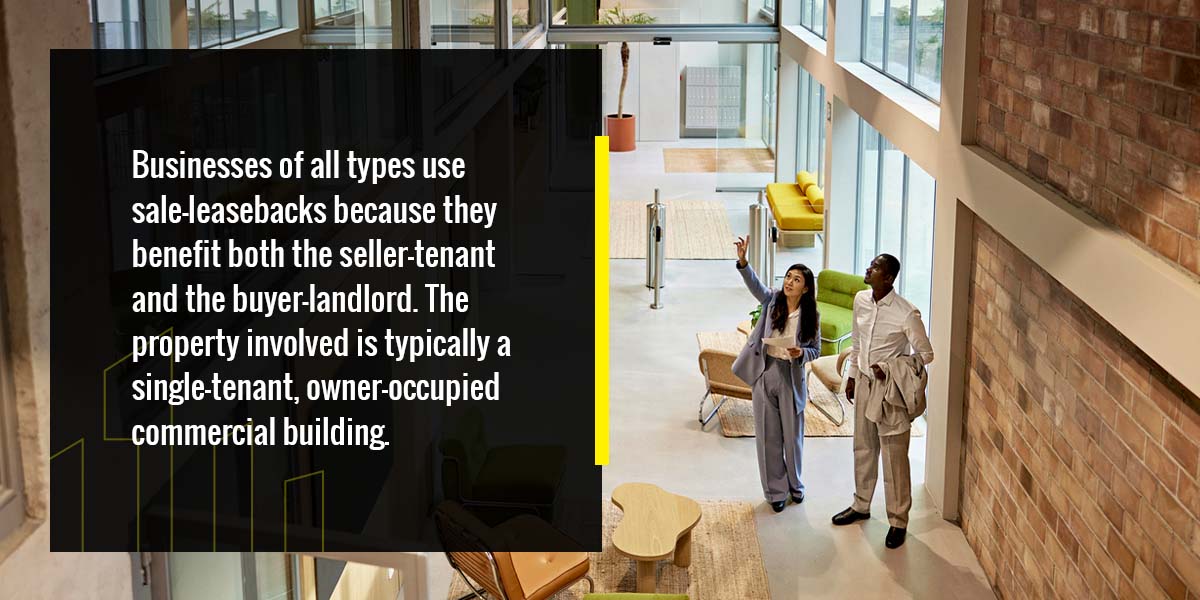
A commercial real estate sale-leaseback is a specific kind of agreement between a property seller and a buyer. This arrangement has several benefits for property owners, especially businesses seeking an alternative financing option. Learn more about real estate sale-leasebacks and their advantages and disadvantages for sellers and buyers.
What Is a Sale-Leaseback?
A sale-leaseback is a simultaneous agreement to sell a property and lease the property from the buyer after the sale. In commercial real estate, a sale-leaseback is most commonly an arrangement where a company that owns and occupies property sells that asset to an investor, who then leases the property back to the seller for a specified period. After the sale, the seller becomes a tenant or lessee, and the buyer becomes their landlord or lessor.
Understanding the Purpose of Leasebacks in Commercial Real Estate
Many companies look to sale-leasebacks as an alternative to traditional financing since they allow companies to improve cash flow and raise capital without disrupting day-to-day operations.
When a company needs cash, it has a few options. It can take out a loan, issue stock through equity financing or sell assets. A company might not see selling assets as a viable option if they need them to run the business. However, a sale-leaseback agreement allows a company to sell assets but still use them by leasing them back from the buyer.
Business owners can use sale-leasebacks to raise funds by selling property and continue to use the property without owning it. Purchasing property through a sale-leaseback agreement reduces investor risk since they get a long-term tenant when they buy the property.

Who Uses Leasebacks and Who Benefits From Them?
Businesses of all types use sale-leasebacks because they benefit both the seller-tenant and the buyer-landlord. The property involved is typically a single-tenant, owner-occupied commercial building. Warehouses, restaurants, convenience stores and banks are often good candidates for sale-leasebacks. Retail buildings, multifamily properties and office buildings can also use these agreements.
Small businesses and large corporations can benefit from selling real estate to maximize capital for daily operations or expansion. National chains can even bundle multiple properties into a portfolio to sell to institutional investors. Any company looking for alternative financing can use a sale-leaseback to get an infusion of cash into the business and the ability to keep using the property.
Buyers look to sale-leaseback transactions for the relative stability and reduced risk they offer as investments. A seller-tenant usually signs a long-term triple net (NNN) lease, which means investors receive a steady income without management responsibilities since the tenant pays for maintenance, property insurance and property taxes.
Imagine a manufacturing company owns the building it occupies and large, specialized manufacturing equipment. The company needs cash for any reason — perhaps to upgrade the equipment or open a second location — but it can’t sell the equipment because it’s necessary to keep manufacturing products. The business owner may be open to selling the property but doesn’t want to move the business.
Arranging a sale-leaseback allows the company to raise the funds needed without having to sell equipment or relocate, and the investor acquires an occupied, income-producing property.
Pros and Cons of Sale-Leaseback Agreements
Sale-leasebacks can provide many benefits to sellers and buyers. However, there are some potential downsides to consider.
Pros of Sale-Leaseback Agreements
Here are some of the benefits of sale-leasebacks for seller-tenants:
- Improved balance sheet: Selling a mortgaged property removes the debt related to that property, improving a company’s balance sheet and debt-to-equity ratio.
- Liquidated equity: Selling also allows a company to convert an illiquid asset into liquid capital. In other words, a company can get cash for the value tied up in the property.
- Full market value: Traditional financing generally loans no more than 80% of an asset’s value. When a company sells property rather than mortgaging it, they can get 100% of the market value out of the asset.
- Increased purchase price: The guaranteed tenancy of a leaseback often brings a premium purchase price compared to vacant properties or those with short-term leases in place.
- Control of the property: With a NNN lease, companies effectively maintain possession and control of the property without tying up as many financial resources or being legally responsible.
- Favorable lease terms: Businesses can negotiate lease terms such as length, rental rate and other conditions necessary for operations that they might not be able to include otherwise. They can also lock in a low rental rate for decades — many long-term leases last 15-20 or even 30 years.
These are the main benefits of sale-leaseback agreements for buyer-landlords:
- Guaranteed tenant: Because the seller rents the property after the sale, landlords have a guaranteed tenant and don’t need to spend time or energy looking for one.
- Reliable income stream: Since the property already has a tenant, landlords can expect reliable rental income for the life of the lease.
- Protection from market swings: Long-term leases such as those in sale-leaseback agreements can protect investors from market swings. Even if rental rates decrease, the tenant still pays the same amount monthly.
- Relatively low risk: A NNN lease reduces some of the risks of owning real estate since the tenant is responsible for maintaining the property and paying for insurance and taxes.
- Few management responsibilities: Because the tenant shoulders many of the tasks associated with owning the property, investors can add to their portfolios without taking on many new management responsibilities.
Cons of Sale-Leaseback Agreements
Some of the possible drawbacks of sale-leasebacks for seller-tenants include the following:
- No ownership interest: The main disadvantage of selling is that the tenant no longer has an ownership interest or access to the property’s value and won’t receive anything if the property appreciates.
- The risk of relocation: The tenant has no guarantee that they will be able to renew their lease at the end of the term and continue staying in the building. The landlord may decide to do something else with the property, forcing the business to move.
- Less control: Although the seller-tenant retains some control over the property, they can no longer do whatever they like with it. The lease will likely include restrictions regarding modifications or remodeling, and the tenant will have to consult with the landlord before making any major changes.
- High rental rates: A long-term lease can just as easily lock in high rental rates as low rates. If the market declines, tenants could be left paying above-market rental rates.
Here are the primary drawbacks of sale-leasebacks for buyer-landlords:
- The risk of default: Every leasing transaction carries some risk of the tenant defaulting, which would require the investor to spend time and resources renegotiating the lease or evicting the tenant and finding a new one.
- Low rental rates: Although a long-term lease can protect investors if the market declines, it prevents the landlord from raising rents if the market rates increase.
- Property management issues: Tenants used to owning the property and doing as they please could make changes without proper notification, which could cause disagreements between the tenant and their landlord.
- Ultimate responsibility: A NNN lease stipulates that the tenant maintains the property and pays certain charges. However, the responsibility to pay taxes and keep the property in good condition ultimately falls to the owner.
Work With Zommick McMahon Commercial Real Estate Brokers to Explore Sale-Leaseback Opportunities
If you’re interested in exploring sale-leaseback options, whether as a seller or a buyer, the brokers at Zommick McMahon can help. We have experience with all sides of sale-leasebacks and can represent your business as a seller-tenant or buyer-landlord. Learn more about our buying, selling and investment services, or fill out a contact form to get in touch with a broker.

